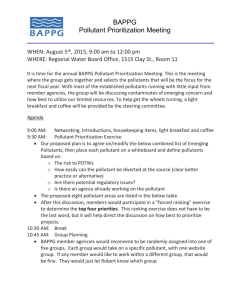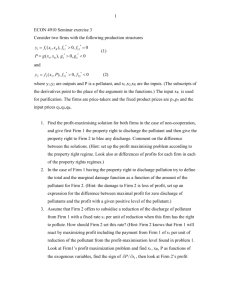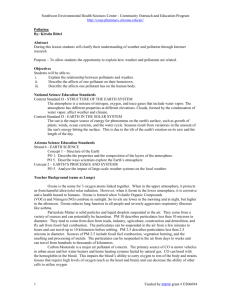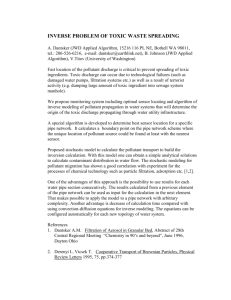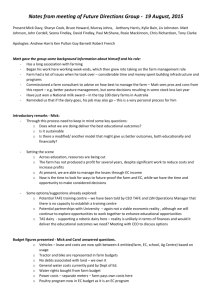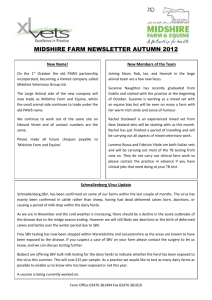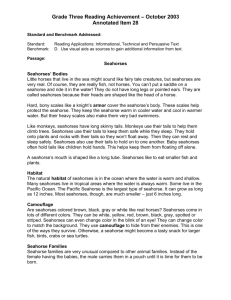Supplemental Materials
advertisement
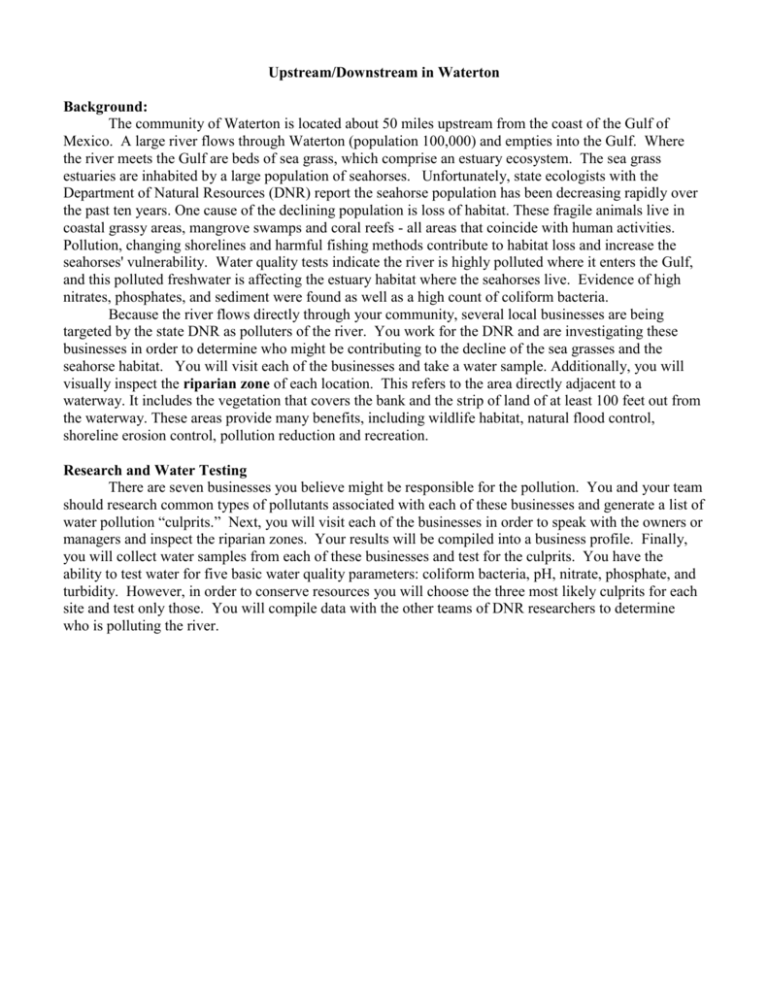
Upstream/Downstream in Waterton Background: The community of Waterton is located about 50 miles upstream from the coast of the Gulf of Mexico. A large river flows through Waterton (population 100,000) and empties into the Gulf. Where the river meets the Gulf are beds of sea grass, which comprise an estuary ecosystem. The sea grass estuaries are inhabited by a large population of seahorses. Unfortunately, state ecologists with the Department of Natural Resources (DNR) report the seahorse population has been decreasing rapidly over the past ten years. One cause of the declining population is loss of habitat. These fragile animals live in coastal grassy areas, mangrove swamps and coral reefs - all areas that coincide with human activities. Pollution, changing shorelines and harmful fishing methods contribute to habitat loss and increase the seahorses' vulnerability. Water quality tests indicate the river is highly polluted where it enters the Gulf, and this polluted freshwater is affecting the estuary habitat where the seahorses live. Evidence of high nitrates, phosphates, and sediment were found as well as a high count of coliform bacteria. Because the river flows directly through your community, several local businesses are being targeted by the state DNR as polluters of the river. You work for the DNR and are investigating these businesses in order to determine who might be contributing to the decline of the sea grasses and the seahorse habitat. You will visit each of the businesses and take a water sample. Additionally, you will visually inspect the riparian zone of each location. This refers to the area directly adjacent to a waterway. It includes the vegetation that covers the bank and the strip of land of at least 100 feet out from the waterway. These areas provide many benefits, including wildlife habitat, natural flood control, shoreline erosion control, pollution reduction and recreation. Research and Water Testing There are seven businesses you believe might be responsible for the pollution. You and your team should research common types of pollutants associated with each of these businesses and generate a list of water pollution “culprits.” Next, you will visit each of the businesses in order to speak with the owners or managers and inspect the riparian zones. Your results will be compiled into a business profile. Finally, you will collect water samples from each of these businesses and test for the culprits. You have the ability to test water for five basic water quality parameters: coliform bacteria, pH, nitrate, phosphate, and turbidity. However, in order to conserve resources you will choose the three most likely culprits for each site and test only those. You will compile data with the other teams of DNR researchers to determine who is polluting the river. Schematic Layout of Waterton The arrow indicates the direction of water flow through the town. Business Profiles Dairy Farm – This dairy farm is located on the banks of the rivers. The farm is very picturesque; the barn is located on a hill overlooking the river, and the pastures contain several lush trees and lots of verdant grass. There are approximately 100 cows grazing in the pasture, which is surrounded by a white wooden fence. When you speak to the owner, she tells you that they’ve never thought about water pollution. She seems taken aback by your suggestion that the cows might be polluting the river water; she assures you that her cows eat only the finest grass during the summer and hay during the winter. Additionally, she doesn’t treat the pasture with any fertilizers or pesticides. Sewage Treatment Plant – Although it is not directly on the river, a pipe from the plant releases effluent into the river. This sewage treatment plant was built in 1952 and has been operating continuously since. It serves the entire city of Waterton. During your conversation with the plant manager, he assures you that they test the plant’s effluent for pollutants, especially coliform bacteria. However, when you ask to see the test results the manager claims to have misplaced them. Thus you check the state’s records to verify the plant is in accordance with the Clean Water Act and discover this plant hasn’t filed a water testing report in over 10 years. They have been fined small amounts for not complying with state regulations. Riverview Golf Course – This 18-hole golf course overlooks the river and it is renowned for the views from the clubhouse. When you visit the golf course, you notice that the grass is incredibly green and well-manicured, and the course is an attractive array of rolling hills. Additionally, you see several sprinkler systems at work. The manager of the golf course is very proud of the grounds and tells you that the course received an award as the best course in the county last year. When you ask how the grass is maintained, he informs you that the groundskeepers regularly test the soils for nutrients and formulate a mixture of fertilizers based upon the needs of the soil and that only the highest quality grass fertilizers are used. As you take one last look around, you notice that at the lowest point of the course’s elevation is a pond which is full of many plants. Fine Pine Lumber Mill – The moment you get out of your car you are overwhelmed by the sound of saws at work. You notice that there is a small patch of standing pine trees close to the river. However, most of the ground is either uncovered or is covered by large stacks of cut pine trees. The saw mill is located at the far edge of the property away from the river and there are several large piles of sawdust surrounding it. You speak with the owner of the land, who is also president of the lumber company. He tells you that his company has nothing to do with the river; they don’t use the water to run the saw mill or for any type of clean-up. He seems surprised to hear that the river is considered polluted and causing problems downstream. River Place Apartment Complex – This apartment complex is currently under construction. When you drive to the site, you see a lot of construction equipment and realize the complex is only at the beginning stages of development. Essentially, there is a large plot of land cleared of all vegetation, at least ten flat concrete foundations and the steel beams framing the outline of what will eventually be many large buildings. You also notice orange mesh fencing around all edges of the construction site. You ask to speak to the apartment manager, who is unavailable at the moment. However the construction site manager speaks to you. He doesn’t know about water testing, but is certain that because so little has been done on the site, there is no way they are polluting the river. Cornfield – This large cornfield and farmhouse is owned by Sonny Day and his wife and is located along the banks of the river. During your visit, you notice that approximately half the land is covered in corn, but half the land is unplanted. The unplanted portion has nothing growing on it and is just exposed dirt and some weeds. You also notice that the field next to the Dairy Farm and the river is completely surrounded by bales of hay. You speak to the elderly couple who runs the farm and they tell you this land has been in the Day family for over 100 years and they’ve been farming corn on it the entire time. Mrs. Day laments that none of their children or grandchildren have any interest in the farm, which is why half of the land is not planted; Mr. Day can’t do all the work by himself. When you ask about fertilizer, Mr. Day enthusiastically tells you about his favorite brand of fertilizer and how it quadrupled his corn production. You are curious about the bales of hay, and ask Mr. Day why these bales surround his fields. He replies that sometimes the cows from the dairy next door break out of their fence and trample his crops. However, the hay keeps them out of the fields. Clay Mine – This is a small quarry that consists of large piles of dirt surrounding tiered layers of rock going deep into the ground. The mine itself is located away from the river; the land adjoining the river has trees, bushes, and grasses on it. Surrounding the quarry are several large pieces of machinery and two large trucks for transporting the mined product. You speak with the owner, Mr. K.O. Lin, who tells you that it’s not a very large mine and does very little business any more. Apparently, most of the valuable clay was mined out over 50 years ago. Name Research and Data Collection for Upstream/Downstream 1. Conduct background research about sea grass beds and seahorses. a) Where along the Gulf of Mexico are sea grass beds found? Name the abiotic conditions that are typically found in these ecosystems. b) What sort of animals are seahorses? What do they eat and what eats them? What are the habitat requirements of a seahorse? c) Draw a food web of the sea grass ecosystem, including the seahorses. d) Explain how pollutants from a freshwater ecosystem (the river) could have an effect on the sea grass beds, which are estuaries located along the coast of the ocean. 2. Complete the data tables below with your results according to the following instructions: a) Briefly research each of the following pollutants or water conditions to discover common sources and effects on the sea grass ecosystem: coliform bacteria, pH, nitrate, phosphate, and sediment (turbidity). b) Choose 3 pollutants that you are interested in testing. Formulate a hypothesis about each business and the pollutant (ex: Could a Dairy Farm be producing nitrogen that gets into the river?). Explain what about the business could be producing that pollutant. If the business is not likely to be producing that pollutant, write “not a likely source.” c) Research preventative measures each business could have in place to either prevent production of the pollutant or to prevent the pollutant from washing into the river through runoff. Based on the business profiles, determine if any preventative measures are in place and explain how it works. d) Conduct the water quality tests with the samples provided by your teacher. Record the appropriate results for each test in the results column. 3. The class will share data from each group’s tests. Record this in the data table. 4. Answer the conclusion questions at the end. 5. Be prepared to have a class discussion about each of the businesses and their effects on water quality. Pollutant Notes Pollutant or condition Nitrate Phosphate Coliform bacteria pH Sediment Common Source Effects on Sea Grass Ecosystems Potential Pollutant 1: Effect of the pollutant on water quality & seahorses: Business Dairy Farm Sewage plant Golf course Lumber mill Apartments Cornfield Clay Mine Business Hypothesis Preventative Measures Test Results Potential Pollutant 2: Effect of the pollutant on water quality & seahorses: Business Dairy Farm Sewage plant Golf course Lumber mill Apartments Cornfield Clay Mine Business Hypothesis Preventative Measures Test Results Potential Pollutant 3: Effect of the pollutant on water quality & seahorses: Business Dairy Farm Sewage plant Golf course Lumber mill Apartments Cornfield Clay Mine Business Hypothesis Preventative Measures Test Results Class Data Business Name Dairy Farm Sewage plant Golf course Lumber mill Apartments Cornfield Clay Mine Nitrate Results Phosphate Results Coliform Results pH Results Turbidity Results Conclusion Questions: 1. Look up the terms point source pollutant and non-point source pollutant. For each of the businesses, explain if they are polluting through point or non-point sources. Dairy Farm Sewage plant Golf course Lumber mill Apartments Cornfield Clay Mine 2. Who is most responsible for polluting the sea grass ecosystem and killing the seahorses? Explain. 3. Can anything be done with Waterton’s businesses to increase seahorse populations? 4. For each business, write a one-two sentence recommendation telling how to decrease the amount of pollutants each is producing as well as ways to prevent pollutants from entering the river. Dairy Farm Sewage plant Golf course Lumber mill Apartments Cornfield Clay Mine
